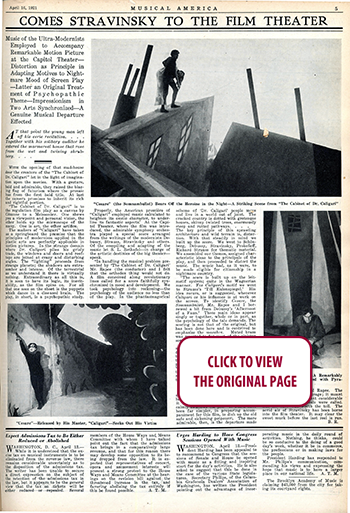 100 YEARS AGO IN MUSICAL AMERICA (388)
100 YEARS AGO IN MUSICAL AMERICA (388)
April 16, 1921
Page 5
COMES STRAVINSKY TO THE FILM THEATER
Music of the Ultra-Modernists Employed to Accompany Remarkable Motion Picture at the Capitol Theater—Distortion as Principle in Adapting Motives to Nightmare Mood of Screen Play—Latter an Original Treatment of Psychopathic Theme—Impressionism in Two Arts Synchronized—A Genuine Musical Departure Effected
AT that point the young man left off his eerie recitation. . . . Together with his solitary auditor he entered the marmoreal house that rose from the wet and twining shrubbery. . . .
WITH the opening of that mad-house door the creators of the “The Cabinet of Dr. Caligari” let in the light of imagination upon the movies. With a gesture, bold and admirable, they raised the blazing flag of futurism where the prosaic has from the first held title. At last the camera promises to inherit its rich and rightful portion.
“The Cabinet of Dr. Caligari” is to the regulation film play as a canvas by Cézanne to a Meissonier. One shows you a viewpoint and personal vision, the other holds up the microscope of the many. One is art, the other artifice.
The makers of “Caligari” have taken as a springboard the premise that the principles of modernism applied in the plastic arts are perfectly applicable in motion pictures. In the strange domain where Dr. Caligari plies his grisly trade, the windows and doors and rooftops are joined at crazy and disturbing angles. The “lighting” proceeds from strange planets; the shadows are extra-somber and intense. Of the terrestrial as we understand it there is virtually nothing. Extraordinary as all this is, it is seen to have its logic, its inevitability, as the film spins on. For all that one sees on the sheet is the puppets which dance in a diseased brain. The play, in short, is a psychopathic study.
Properly, the American premiere of “Caligari” employed music calculated to heighten its exotic character, to underline its fantastic aspects. At the Capitol Theater, where the film was introduced, the admirable symphony orchestra played a special score arranged from the writings of the modernists Debussy, Strauss, Stravinsky and others. Of the compiling and adapting of the music let S. L. Rothafel—in charge of the artistic destinies of the big theater—speak.
“In handling the musical problem presented by ‘The Cabinet of Dr. Caligari’ Mr. Rapee (the conductor) and I felt that the orthodox thing would not do. A film conceived along revolutionary lines called for a score faithfully synchronized in mood and development. We took psychology into reckoning—the psychology of the audience no less than of the play. In the phantasmagorical scheme of ‘Dr. Caligari’ people move and live in a world out of joint. The cracked country is dotted with grotesque houses, skinny twisted trees, enormously steep and rutted pathways. . . . The key principle of this sprawling architecture and wild terrain is, distortion. With that steadily in mind we built up the score. We went to Schonberg, Debussy, Stravinsky, Prokofieff, Richard Strauss for thematic material. We assembled our themes, assigned characteristic ideas to the principals of the play, and then proceeded to distort the music. The music had, as it were, to be made eligible for citizenship in a nightmare country.
“The score is built up on the leitmotif system; quite in the Wagnerian manner. For Caligari’s motif we went to Strauss’s 'Till Eulenspiegel.' His idea recurs, or is suggested, whenever Callgari or his influence is at work on the screen. To identify Cesare, the Somnambulist, Mr. Rapee and I borrowed a bit from Debussy’s ‘Afternoon· of a Faun.’ These main ideas appear singly or together, whole or in part, as the psychology of the tale demands. The scoring is not that of the original, but has been done here and is contrived to emphasize the macabre. Muted brass was resorted to for most of the sinister sounds.
“I think I may confidently, and justly, say that the whole represents the most daring musical achievement in the history of the American motion-picture theater. We tried very hard with this picture, because we think so much of it. ‘Caligari’ is, to my mind, an imaginative masterpiece and a triumph as directing. Musically no less than pictorially it opens up a virgin country.”
___________
As briefly back as five years Stravinsky or Schonberg in the movie-house belonged to the inconceivable. To-day it calmly happens, and the audience calmly swallows the pill. It would have been far simpler, in preparing accompaniment for this film, to dish up the old safe and sickening potpourri. The more admirable, then, is the departure made by Messrs. Rothafel and Rapee. The thing took more than courage; it meant double labor and it meant considerable expense. Four rehearsals were called. But the tune was worth the toll. The acrid air of Stravinsky has been borne into the film theater. It may clear the sweet murk before the last reel is run. —B. R.




 RENT A PHOTO
RENT A PHOTO





